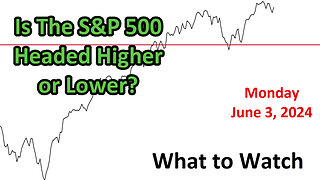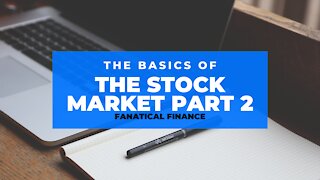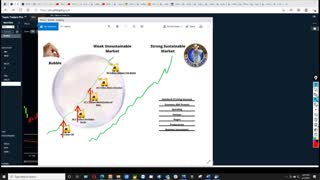Free Stock Market Course Part 11: Liquidity
Free File downloads
Course notes, Audio files, Assessments, Transcript files, and Course Outline: https://spxinvestingblog.com/downloads/
My Exclusive Free Workshop: The Four P's of Building a Successful Investing Program → https://spxinvesting.mailchimpsites.com
Blog: https://spxinvestingblog.com
Facebook Group: https://www.facebook.com/groups/433843641082343
Chapters:
00:00 Liquidity
03:09 Liquidity in the Stock Market
06:38 Famous High-Volume Days
09:09 Famous Percentage Loss Days
12:10 Using Only Numbers Can Be Misleading
15:43 Liquidity in the SPX Investing Program
Module 3 Section 3
Liquidity
Liquidity is essential when owning any asset, such as stocks.
For example, you may have an asset that is worth $20 million.
If you tried to sell that asset, could you sell it quickly?
If not, how valuable is that asset?
It is necessary to find a buyer.
Also, completing a transaction can take a long time.
It may be necessary to hire a Broker or an Agent to try to find a buyer for you.
Liquidity allows you to buy or sell something quickly.
Liquidity in the Stock Market
One of the great things about the stock market is that there’s been a tremendous increase in daily volume over the last couple of decades.
In the early 1990s, it would be typical for there to be a daily volume of over 300-400 million shares on the New York Stock Exchange.
Currently, a slow day on the New York Stock Exchange is considered anything under 1 billion shares.
This means that a lot of investors are trading every day.
This volume consists of Institutions, Banks, Hedge Funds, Individual Investors, and so on.
It is estimated that 60%-90% of the volume is computer-driven.
Famous High Volume Days
1929 Stock Market Crash
The stock market crashed over a period of five days.
The first sign of trouble was on Black Thursday – Oct. 24, 1929.
At that time, the volume on the stock exchange was around 4 million shares each trading day.
But on Black Thursday, a record 12.9 million shares were exchanged.
1987 Stock Market Crash
595 million shares were traded, which overwhelmed the systems and prevented many investors from being able to sell.
Famous Percentage Loss Days
1929 Stock Market Crash
In late October 1929, the stock market crashed over a period of several days, wiping out 40 percent of the paper values of common stock.
1987 Stock Market Crash
On Oct. 19, 1987, a day that became known as “Black Monday,” the stock market crashed as the Dow Jones Industrial Average plunged 508 points, or 22.6 percent in value, its largest single-day percentage drop. The crash came after a two-week period in which the Dow had dropped 15 percent.
2020 COVID-19 Outbreak
On March 16, 2020, the Dow lost 12.9%.
Between Feb. 19, 2020 and March 19, 2020, the Dow shed over 35% of its value.
Using Only Numbers Can Be Misleading
When discussing significant up or down days, the media often makes at least two mistakes in order to make things sound more dramatic:
1. The gain or loss is reported as numbers when the vital factor should be the percentage gain or loss.
The focus is on the DJX when the focus should be on the SPX.
Another mistake, which is worth mentioning, is when the media says something such as:
“We have not been at this level since 1994”.
The statement is true, but the context can be misleading.
There are times, however, when investors should pay close attention to numbers, such as when implementing strategies that are numbers-based. This includes strike prices for options.
Liquidity in The SPX Investing Program
The Liquidity of the SPX was the main reason for developing these programs.
The SPY, as well as other ETFs and Options, are very liquid.
This allows for strategies, both simple and complex, to be filled at tighter Bid/Ask Spreads.
Techniques and strategies taught in The SPX Investing Program can easily be transferred to other liquid markets such as the DJX, NDX, and other ETFs with high average daily volume and liquid options.
-
 44:44
44:44
The SPX Investing Program
8 hours agoS&P 500 What to Watch for Tuesday June 3, 2024
291 -
 21:15
21:15
The SPX Investing Program
2 years ago $0.01 earnedFree Stock Market Course. Part 6: ETFs
289 -
 4:19
4:19
Fanatical Finance
2 years agoUnderstanding the Stock Market Part 2! | What is the Stock Market?
645 -
 8:17
8:17
The Phil's Gang Radio Show Channel
2 years agoStock market crash starting to unfold part 22
63 -
 8:51
8:51
The Phil's Gang Radio Show Channel
2 years agoStock market crash starting to unfold part 16
29 -
 LIVE
LIVE
Vigilant News Network
5 hours agoMedia Blackout: 10 News Stories They Chose Not to Tell You - Episode 25
898 watching -
 12:00
12:00
Dr. Eric Berg
1 day agoWhat Exercise Burns the Most Calories?
6.76K28 -
 4:48:29
4:48:29
LumpyPotatoX2
5 hours ago$10,000 PUBG Tournament w/GamersError - #RumbleTakeover
6.19K2 -
 3:22
3:22
One Bite Pizza Reviews
2 days agoBarstool Pizza Review - Marco Pizzeria & Restaurant (Branford, CT)
12K19 -
 41:46
41:46
Standpoint with Gabe Groisman
10 hours agoEp. 27. From GameStop to the NBA. Gabe Plotkin
14.3K3